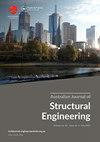Fatigue performance of bolted shear connectors
IF 1.3
Q4 ENGINEERING, CIVIL
Australian Journal of Structural Engineering
Pub Date : 2021-11-21
DOI:10.1080/13287982.2021.1999010
引用次数: 1
Abstract
ABSTRACT A computer-aided engineering (CAE) fatigue life prediction technique is developed in this paper to determine the fatigue strength of bolted shear connectors in composite structures. A relatively new initiative in the composite construction industry is the use of the blind boltshear connector, which provides a sustainable and practical solution to the main limitation of using traditional welded stud regarding reuse of building components. Furthermore, fatigue is one of the major causes involved in fatal mechanical failures of composite structures. However, limited research has been currently undertaken to assess fatigue life of composite structure. Therefore, the fatigue performance of the blind bolt under constant amplitudes cyclic loading has been investigated using ABAQUS/explicit and FE-SAFE programs. First, the dynamic responses of steel-concrete composite structures under sinusoidal load cycles were simulated using ABAQUS/explicit. Then, the stress–strain time history based on the response law of the composite structure was introduced into the FE-SAFE software to obtain a good prediction on the fatigue life of the blind bolt shear connector. As a result, the logarithmic life distributions of the bolted shear connector were calculated using different constant amplitudes.螺栓剪切连接件的疲劳性能
为确定复合材料结构中螺栓剪切连接件的疲劳强度,提出了一种计算机辅助工程(CAE)疲劳寿命预测技术。复合材料建筑行业的一项相对较新的举措是使用盲螺栓剪切连接器,它为使用传统焊接螺柱的主要限制提供了可持续和实用的解决方案,涉及建筑部件的再利用。疲劳是复合材料结构发生致命力学失效的主要原因之一。然而,目前对复合材料结构疲劳寿命的评估研究有限。为此,采用ABAQUS/explicit和FE-SAFE程序对盲杆在恒幅循环加载下的疲劳性能进行了研究。首先,采用ABAQUS/explicit软件对钢-混凝土组合结构在正弦荷载循环作用下的动力响应进行了模拟。然后,将基于复合结构响应规律的应力-应变时程引入到FE-SAFE软件中,对盲栓剪切连接件的疲劳寿命进行了较好的预测。结果表明,采用不同的等幅值计算了螺栓剪切连接件的对数寿命分布。
本文章由计算机程序翻译,如有差异,请以英文原文为准。
求助全文
约1分钟内获得全文
求助全文
来源期刊

Australian Journal of Structural Engineering
ENGINEERING, CIVIL-
CiteScore
2.50
自引率
0.00%
发文量
31
期刊介绍:
The Australian Journal of Structural Engineering (AJSE) is published under the auspices of the Structural College Board of Engineers Australia. It fulfils part of the Board''s mission for Continuing Professional Development. The journal also offers a means for exchange and interaction of scientific and professional issues and technical developments. The journal is open to members and non-members of Engineers Australia. Original papers on research and development (Technical Papers) and professional matters and achievements (Professional Papers) in all areas relevant to the science, art and practice of structural engineering are considered for possible publication. All papers and technical notes are peer-reviewed. The fundamental criterion for acceptance for publication is the intellectual and professional value of the contribution. Occasionally, papers previously published in essentially the same form elsewhere may be considered for publication. In this case acknowledgement to prior publication must be included in a footnote on page one of the manuscript. These papers are peer-reviewed as new submissions. The length of acceptable contributions typically should not exceed 4,000 to 5,000 word equivalents. Longer manuscripts may be considered at the discretion of the Editor. Technical Notes typically should not exceed about 1,000 word equivalents. Discussions on a Paper or Note published in the AJSE are welcomed. Discussions must address significant matters related to the content of a Paper or Technical Note and may include supplementary and critical comments and questions regarding content.
 求助内容:
求助内容: 应助结果提醒方式:
应助结果提醒方式:


